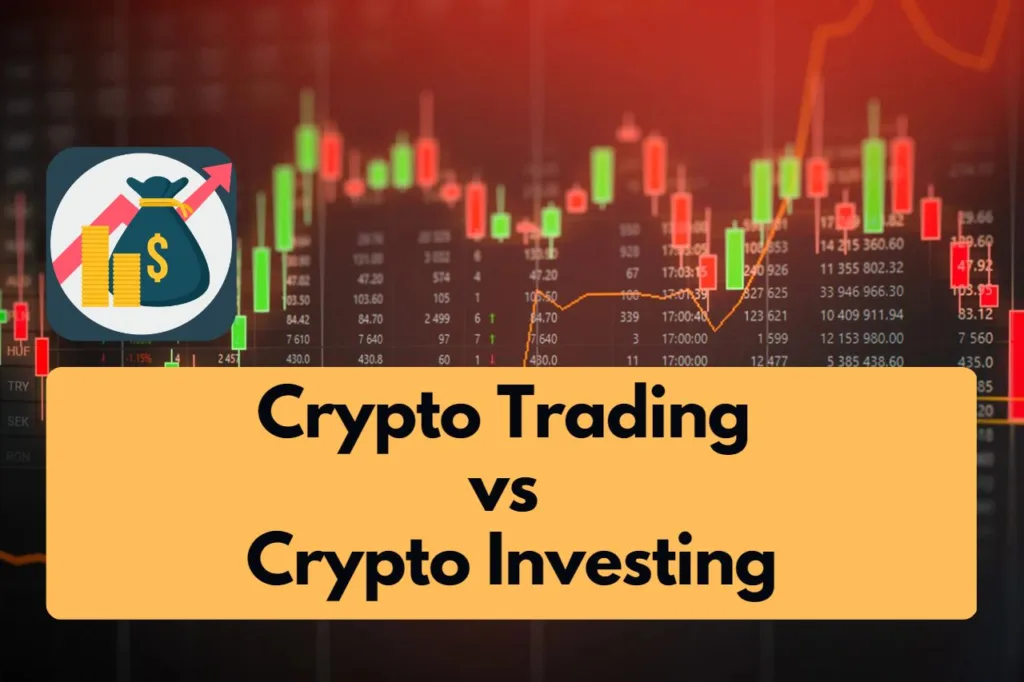Key Differences Explained

🤔 Are you interested in investing in cryptocurrencies but not sure whether to trade or invest? This article will explain the key differences between cryptocurrency trading and investing to help you make an informed decision.
What is Cryptocurrency Trading?
💰 Cryptocurrency trading involves buying and selling digital currencies, either through an exchange or directly with other traders. Traders aim to profit from short-term price fluctuations in the market by buying low and selling high.
Crypto trading is an active form of investing. Traders use technical analysis and market research to determine when to buy or sell digital assets. The goal of trading is to make a profit in the short-term, typically within a day or a few days. Cryptocurrency traders usually use leverage, which is a type of borrowing, to amplify their returns.
Pros of Cryptocurrency Trading:
📈 High potential for profit: Trading can offer quick and substantial gains if done correctly.
🕹️ Flexibility: Traders can enter and exit positions at any time.
🧠 Active involvement: Trading can be exciting and intellectually stimulating.
Cons of Cryptocurrency Trading:
📉 High risk: The volatility of the crypto market makes trading risky and unpredictable.
⏰ Time-consuming: Successful trading requires continuous monitoring of the market and analysis of trends and news.
😫 Stressful: The pressure to make quick decisions can lead to emotional reactions and errors.
What is Cryptocurrency Investing?
💸 Cryptocurrency investing involves buying and holding digital assets for the long-term, with the expectation of significant growth over time. Investors aim to identify promising projects and technologies and invest in them for their potential to deliver returns over time.
Crypto investing is a passive form of investing. Investors buy and hold digital assets, typically for months or years. The goal of investing is to generate long-term profits. Unlike trading, investors do not use leverage, and they do not typically engage in short-term trades.
Pros of Cryptocurrency Investing:
🚀 Lower risk: Long-term investments are generally less volatile than short-term trading.
📈 Passive income: Holding assets for the long term can generate passive income through staking or dividends.
💰 Potential for exponential growth: Investing in a promising project early on can result in significant returns over time.
Cons of Cryptocurrency Investing:
🔒 Lower liquidity: Investors may have to hold assets for extended periods before realizing a profit.
⏳ Slower returns: Unlike trading, investing may require patience and a longer-term outlook.
❓ Uncertainty: The future of any cryptocurrency project is uncertain, and investing always carries some degree of risk.
Key Differences Between Cryptocurrency Investing and Trading
- ⏰ Time horizon: Trading focuses on short-term gains while investing takes a long-term perspective. Traders aim to make quick profits, while investors aim to generate long-term profits through asset appreciation and passive income streams.
- 🧠 Approach: Trading is more active and reactive, while investing is more passive and strategic. Traders rely on technical analysis, market trends, and news to make trades, while investors focus on identifying high-potential projects and holding them for the long term.
- 📉 Risk: Trading carries higher risk due to the volatility of the market, while investing is generally less risky but also less profitable in the short term. Trading involves more leverage and short-term trades, while investing involves buying and holding assets for the long term.
Cryptocurrency Trading Strategies 🔄💹📈📉👨💻
If you are considering crypto trading, here are some common strategies that traders use:
Day Trading 📊💻👨💼
Day trading involves buying and selling digital assets within the same day. Day traders analyze market data and closely monitor price charts to identify patterns and trends. They aim to take advantage of small price movements and make multiple trades throughout the day.
Swing Trading 📈📉🔄👨🏫
Swing trading involves buying and holding assets for a few days to a few weeks, taking advantage of price swings in the market. Swing traders use technical analysis to identify potential entry and exit points and aim to capture price movements over a short period.
Scalping 📉📈👨💼💰
Scalping is a high-frequency trading strategy that involves making many trades in a short amount of time, usually seconds or minutes. Scalpers aim to profit from small price movements by buying and selling quickly. This strategy requires close monitoring of the market and the use of high leverage to amplify returns.
Cryptocurrency Investing Strategies 💰🚀👨🔬
If you are considering crypto investing, here are some strategies that investors use:
Dollar-Cost Averaging (DCA) 💲🔄📈
Dollar-cost averaging involves investing a fixed amount of money at regular intervals, regardless of the market price. This strategy helps to average out the cost of buying digital assets over time, reducing the impact of market volatility.
Buy and Hold 🚀📈💰
Buy and hold is a strategy that involves buying digital assets and holding them for the long term, regardless of short-term price fluctuations. This strategy requires patience and a long-term outlook and is best suited for investors who believe in the potential of a particular project or technology.
Fundamental Analysis 🤔📊👨🔬
Fundamental analysis involves researching the underlying technology, team, and community of a particular cryptocurrency project to determine its long-term potential. This strategy requires a deep understanding of the industry and an ability to identify promising projects and technologies.
Conclusion 🤝💡
Whether you choose to trade or invest in cryptocurrencies, it’s important to understand the key differences between these two approaches. Trading can offer high potential for profit but also carries high risk and can be stressful and time-consuming. Investing, on the other hand, is generally less risky but requires patience and a long-term outlook.
Whatever strategy you choose, it’s important to do your research, stay informed about the market, and make informed decisions based on your risk tolerance and investment goals. By understanding the key differences between trading and investing, you can make an informed decision about how to approach investing in cryptocurrencies.



